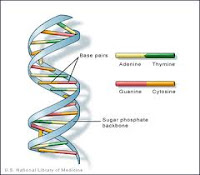Nucleic Acids Structure
Nucleic acids, biochemical compounds that control the structure of proteins. The first nucleic acid was detected in the late 1860s by Swiss F. Miescher, who isolated it from the cell nucleus. The compound reacted acid and was soluble in base. It was called nucleic acid, a name who is still used, although the nucleic acids have also been found in the cell cytoplasm.
Dividing the nucleic acids in two main groups: deoxyribonucleic acid, DNA (of meadow. Deoxyribo nucleic acid) and ribonucleic acid, RNA (of meadow. R n Igbo ucleicacid). DNA is found mainly in the nucleus, but also in the cytoplasm mitochondria and chloroplasts, while the RNA preferentially found in the cytoplasm.
Structure
Nucleic acids are straight chain polymers, ie the molecules are long chains made up of the same units. A protein is a polymer (polypeptide) with amino acids as building blocks. Similarly, nucleic acid's polynucleotide composed of nucleotides, and thus comes to consist of equal parts of pentose, phosphoric acid and an organic base. Nicely, Osen is ribose at RNA and deoxyribose which in DNA. The four common bases are c adenine and guanine, and thymine pyrimidine derivative, uracil and cytosine. Thymine located merely in DNA; uracil is only in RNA. Nucleotides in the nucleic acid bound together by phosphoric acid molecules, which are esterified to the hydroxyl group at carbon atom 3 in one pretty mouth and the carbon atom 5 in the next pretty mouth. Chromosomes can be DNA molecules of several hundred million joints.






